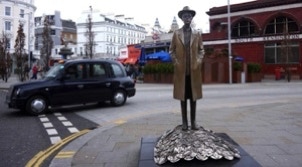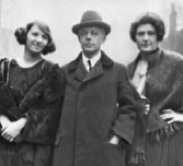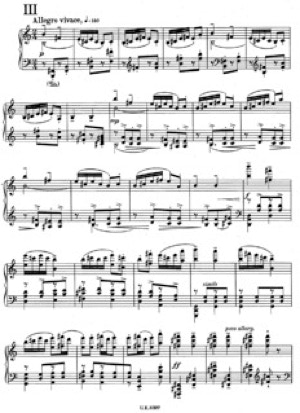BELÁ BARTÓK (1881-1945)
CHRONOLOGY OF LIFE & WORKS

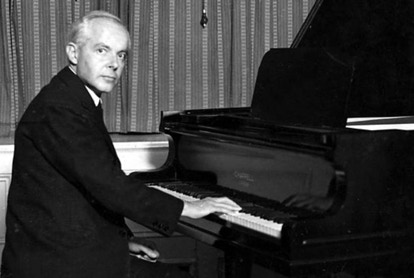
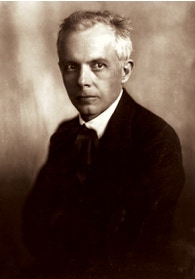
EARLY YEARS
Bartók was born in the tiny city of Nagyszentmiklós, in Hungary (it is now part of Romania) on March 25, 1881. He was a true child prodigy: one of the few major composers of the 20th century who indeed WAS a child prodigy (Prokofiev was the other one). An amazing pianist, he played his first public concert at age 11, including original compositions written two years earlier!
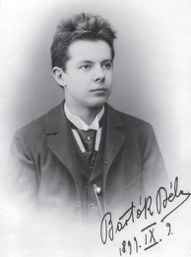





Bartók as a high school student
The Budapest Academy of Music
Bartók made a far-reaching decision in the year 1898: when he was offered a position/scholarship at the Vienna Conservatory, he turned it down and decided to study at the Budapest Academy. This shows his interest in remaining true to his national heritage and his desire, even at the young age of 17, to pursue a nationalistic, Hungarian course. In a letter from this time he wrote that his only objective was “the good of Hungary and of the Hungarian nation.”
There were 3 major influences on the music of Bartók in his early life:

- 1. RICHARD STRAUSS: When Bartók heard Richard Strauss’s tone poem Also Sprach Zarathustra in 1902, he claimed that it was “a lightning stroke”, and it fired him up to compose his own large-scale tone poem in 1903 ( Kossuth ). Strauss of course was the most famous living composer at this time, and was highly influential throughout Europe and the world.

Bartók composed his massive tone poem Kossuth in 1903, the work being highly influenced by Richard Strauss. However, the story is taken from Hungarian nationalism: Kossuth was the Hungarian leader of the 1848 uprising and revolutionary activity that shook the Austrian Empire. The uprising was not a success and Kossuth was exiled from the Austrian Empire, spending the remaining years of his life in Great Britain, America, and Italy.
2. CLAUDE DEBUSSY: Bartók was introduced to the music of Debussy by his good friend Kodály, and he was extremely impressed with the sonorities and harmonies of the French master. Some early Bartok works have more than a bit of Debussy in them, as can be heard in this example, taken from Deux Images for Orchestra, composed by Bartók in 1910.
3. FOLK MUSIC! Bartók made his first trip to the countryside in 1906 to hear REAL folk music played by REAL peasants, and this trip transformed his life. IMPORTANT! In 1905 he began to record and collect folk music (the recording machine had just been invented) and systematically catalogue it and study it. This would remain his passion for most of the rest of his life.


What is true folk music? Most Europeans who listened to “art” music had no idea what true folk music was, since they rarely, if ever, went to the source, i.e. the peasants and the “folk” who lived in the rural parts of the Empire. Most Europeans believed that “folk” music was gypsy music, and that the Brahms Hungarian Dances were based on folk music. None of this is really quite true. Let’s examine in some more detail. For audio examples of folk music and non-folk music imitations and distortions, please visit the AUDIO EXTRAS section of this website (IMPORTANT!).



Folk music is monophonic : there is no harmony
Central and Eastern European folk music makes use of non-major/minor scales, such as pentatonic, modal, synthetic, and gypsy scales

That’s a lot of scales!!

Gypsy Hungarian (also called “double harmonic minor scale”)

Gypsy minor scale

“Acoustic” scale or Lydian/Mixolydian synthetic scale
Mixed modal scales are often termed POLYMODAL CHROMATICISM …..it can also be described as the free alteration of the other notes in a mode once its tonic has been established.

There are no bar lines in folk music (why would there be—it is an oral tradition!) and the music is usually made up of unequal groupings of twos, threes, fives, sevens, etc. (often due to dancing patterns). EXTREMELY COMPLICATED RHYTHMS ENSUE !
Bartók’s achievement was to base his music on this body of folk music, and his main difficulty was to find a harmonic basis for the music, since it was monophonic. He based his very complicated harmony on the melodic aspects of the music and interval relationships, creating a unique 20th century sound. He also made use of much quartal harmony, cluster chords, etc. Bartók’s extremely difficult rhythms are a result of his study of the unequal and intricate rhythms he found in much of the music he recorded and studied while on his field trips into the countryside and all over many parts of central and eastern Europe (not to mention North Africa and Turkey).
Famous Bartók Quote
“The outcome of these studies (of folk music) was of decisive influence upon my work, because it freed me from the tyrannical rule of the major and minor keys.”
Bartók transcribed music from:







Hungary
Romania
Transylvania
Croatia
Slovakia
Turkey
North Africa
AND MANY OTHER PLACES!
THE “EXPRESSIONIST” PERIOD
The period up to 1923 is considered to be Bartók’s “Expressionist” period (similar to both Hindemith and Schoenberg), which is characterized by harsh, biting dissonance, angular music, and the free imitation of folk music with the aim of evoking the primitive force found in certain types of native music.
Some important works from this period are:





Bluebeard’s Castle (1911)
Great stories!
String Quartet no. 2 (1915-17)
The Miraculous Mandarin (1919)
Allegro barbaro for piano solo (1911)



Judith enters his castle with her new husband Bluebeard. When she notes that the dark walls seem to be weeping, he gives her the opportunity to leave. She declines. She sees that there are seven locked doors. Judith insists that the doors be opened, to allow light to enter the forbidding interior, insisting that her demands are based in her love for Bluebeard. There is a sound of the castle itself sighing, as though it anthropomorphically knows what will happen. Bluebeard refuses her, saying that these are private places and asking Judith to love him but ask no questions. Judith demands the keys to the doors, making it a test of Bluebeard’s love for her.
The first door opens to reveal a torture chamber, drenched in blood.
Behind the second door, an armory is revealed. Judith sees all the weapons that Bluebeard has used to conquer his foes. Again there is blood on the weapons.
Bluebeard tries to keep Judith from opening any more doors, but she insists, and he gives her three more keys. Behind the third door, Judith can see mountains of gold and many jewels. It is spectacular but again after she looks for a moment she sees them covered in blood.
Behind the fourth door, a secret garden of great beauty is revealed. Lilies, roses, and bright red carnations delight her eye as Judith looks at the garden. Bluebeard praises the beauties of his garden, but she sees blood on the ground around each of the flowers and she realizes that blood has watered the garden.
When she opens the fifth door, Judith sees Bluebeard’s lands, those he has conquered and those which he has always owned. After her sight of all the glory of her husband, she again sees a film of blood.



Bluebeard again wants her to stop, but she cannot. She must see the remaining two doors. He argues that she has brought light into his dark house. Bluebeard tells her to enjoy what she has seen and go no further, but Judith cannot resist the temptation to continue. She demands the sixth key. When she opens the sixth door, she sees before her a vast, quiet lake. She asks what it is, and Bluebeard tells her that it is a lake of tears, smooth and unearthly.
To get the last key Judith embraces her husband repeatedly, telling him again and again how much she loves him. She insists that he must return her love by allowing her to look into the last door. She even tells him that if he doesn’t allow her to open the last door, she will believe the rumors that he has murdered his previous wives. When Judith opens the last door, three women appear. Bluebeard calls the women morning, noon, and evening. Judith sees that each one is more beautiful than she. Terror finally strikes her, but Bluebeard now inexorably calls her the most beautiful, the wife of “starry, ebony-mantled midnight.”
Judith takes her place with the others, despite her cries to be spared. Bluebeard calls her his fairest and locks all four women behind the seventh door, saying, “All shall be darkness, darkness, darkness.”


After an orchestral introduction depicting the chaos of the big city, the action begins in a room belonging to three tramps. They search their pockets and drawers for money, but find none. They then force a girl to stand by the window and attract passing men into the room. The girl begins a lockspiel — a "decoy game", or saucy dance. She first attracts a shabby old rake, who makes comical romantic gestures. The girl asks, "Got any money?" He replies, "Who needs money? All that matters is love." He begins to pursue the girl, growing more and more insistent until the tramps seize him and throw him out.
The girl goes back to the window and performs a second lockspiel. This time she attracts a shy young man, who also has no money. He begins to dance with the girl. The dance grows more passionate, then the tramps jump him and throw him out too.
The girl goes to the window again and begins her dance. The tramps and girl see a bizarre figure in the street, soon heard coming up the stairs. The tramps hide, and the figure, a Mandarin (wealthy Chinese man), stands immobile in the doorway. The tramps urge the girl to lure him closer. She begins another saucy dance, the Mandarin's passions slowly rising. Suddenly, he leaps up and embraces the girl. They struggle and she escapes; he begins to chase her. The tramps leap on him, strip him of his valuables, and attempt to suffocate him under pillows and blankets. However, he continues to stare at the girl. They stab him three times with a rusty sword; he almost falls, but throws himself again at the girl. The tramps grab him again and hang him from a lamp hook. The lamp falls, plunging the room into darkness, and the Mandarin's body begins to glow with an eerie blue-green light. The tramps and girl are terrified. Suddenly, the girl knows what they must do. She tells the tramps to release the Mandarin; they do. He leaps at the girl again, and this time she does not resist and they embrace. With the Mandarin's longing fulfilled, his wounds begin to bleed and he dies.

Here is a fantastic YouTube link to the ending of The Miraculous Mandarin : have a look!
THE CLASSICAL MIDDLE PERIOD (1923-1937)
Bartók traveled to London and Paris in 1922-23 and discovered what Schoenberg and Stravinsky had been doing since the end of World War I. He also saw what fellow composers and the public found most vital and interesting in his own work, which was indeed the folk element. This prompted a reassessment in Bartók’s mind about the direction he wanted his music to take and the evolution of his style.
This period really begins in 1923 with the Dance Suite for orchestra, which was composed in this year. This is a critically important work in Bartók’s career, and marks a turning point in his style. To listen to and view the score for a portion of this work, please play the audio, then click on the score (opens in a new window):
Greater economy of means, balance, constraint
Bartók redoubles his efforts at what could be derived from folk music
Folk music to the fore
Use of classical forms (Sonata, Concerto, Divertimento, etc.)
Music is somewhat less dissonant and angular
As you listen to the Dance Suite excerpt, bear these points above in mind, as you will detect every one of them in the music!

1923 Dance Suite
1926 Piano Concerto no. 1
1927 String Quartet no. 3
1928 String Quartet no. 4
1928 Two Rhapsodies for Violin and Orchestra
1930 Cantata Profana
1931 Piano Concerto no. 2
1931 Transylvanian Dances
1931 Hungarian Sketches
1934 String Quartet no. 5
1936 Music for Strings, Percussion, and Celesta
1937 Sonata for Two Pianos and Percussion
QUESTION: What is the main difference between Bartók’s “Neo-Classicism” and that of other composers of the time ?
ANSWER: Bartók did not borrow pieces from the past: he still used folk music as his source.
THE FINAL PERIOD (1938-1945)
After Bartók completed his Sonata for Two Pianos and Percussion in 1937, his music shifted once again, and he enters his final period, most of which was spent in America (he emigrated to the USA in 1940). These years were characterized by his illness (signs of leukemia began in late 1940) and difficulties making a living in the United States.






Less rigorous
More fluid
Emphasis on lyricism




Very tonal
Pessimism with the world situation

1938 Violin Concerto no. 2
1938 Contrasts for Clarinet, Violin, and Piano
1939 String Quartet no. 6
1939 Divertimento for String Orchestra
1943 Concerto for Orchestra
1944 Sonata for Violin Solo
1945 Piano Concerto no. 3 (unfinished)
1945 Viola Concerto (unfinished)
SUMMARY THOUGHTS ON BARTÓK






He was not a brilliant, autocratic teacher (i.e. he was not like Schoenberg)
He left no “school” (contrast with Schoenberg…..) of composition
At the time, during his life, he was not considered one of the leading figures in western music (he is today !)
His greatest achievement was to create a synthesis between art music and folk music
TERMS ASSOCIATED WITH BARTÓK








Night music
Tempo giusto style
Parlando-rubato style
Palindromic form/bogen-arch form
Polymodal chromaticism
Gypsy Hungarian scales, acoustic scale, alpha chord, gypsy minor scale

AREN’T YOU GLAD THERE IS NO EXAM ON THIS?

